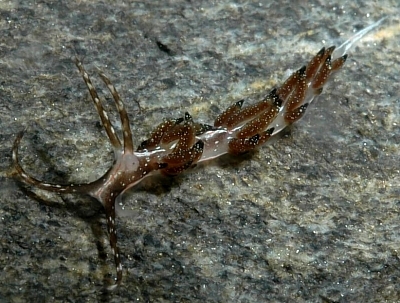
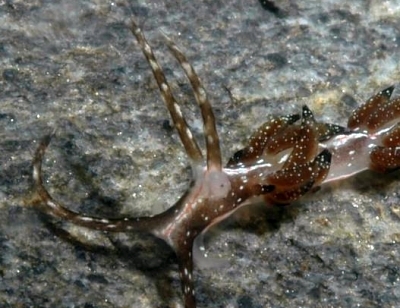
Facelina fusca
Schmekel 1966
Order: NUDIBRANCHIA
Suborder: AEOLIDINA
Family: Glaucidae
DISTRIBUTION
Known only from the Mediterranean.
PHOTO
Platja de Sant Antoni, Badia de Portlligat, Cadaqués, Girona, 4 metres, Spain, Mediterranean Sea, 31 May 2008, Posidonia oceanica meadows. Length: 15 mm. Photographer: Miquel Pontes.
This species has a slender body with spindle shaped cerata arranged in 5 clusters on each side. The first cluster consists of 3 transverse rows, the 2nd an arch, and the rest are single rows. The oral tentacles are longer than the rhinophores which have scattered rounded tubercles. The anterior foot corners are tentacular.
It is greyish black in colour, the cerata being dark brown going to black near the tip. The rhinophores, oral tentacles, and tips of cerata have scattered whitish spots. There is a median reddish line, outlined in white, running from the head to the tail. It is sometimes broken. A similar line runs along each side of body below the cerata. The spiral egg coil orange.
It grows to at least 16mm and is known from the intertidal to 25 m depth. It feeds on the hydroid Eudendrium sp.
-
Schmekel, L (1966) Zwei neue Facelinidae aus dem Golf von Neapel: Facelina (A.) fusca n. sp. und Antonietta luteorufa n. sp., n. gen. (Gastr. Opisthobranchia). Pubblicazioni Stazione Zoologisches Napoli, 35, 29-46.
-
Schmekel, L. & Portmann, A (1982) Opisthobranchia des Mittelmeeres, Nudibranchia und Saccoglossa. Fauna e Flora del Golfo Napoli, 40: 1-410. Springer-Verlag: Berlin
Rudman, W.B., 2005 (April 21) Facelina fusca Schmekel 1966. [In] Sea Slug Forum. Australian Museum, Sydney. Available from http://www.seaslugforum.net/find/facefusc
Related messages
Facelina fusca from Spain
June 5, 2008
From: Miquel Pontes

Concerning message #19253:
Hi Bill,
Here is a nice picture of a Facelina fusca where it shows all the traits theoretically assigned to this species (unlike other pictures on this thread). However, by finding this small and cryptic nudibranch, many questions arose.
We have read this species has been described in Spain only once (Ros, 1975 as Facelina cf. fusca, because the only available animal was in very bad shape for further determination). So maybe this is the second citation of a Facelina fusca in Mediterranean coast of Spain.
We have also read that this animal lives on coralligenous habitat (in our coast this habitat usually begins at -20m) feeding on Eudendrium sp. hydroids, but we found this one in the Posidonia oceanica meadows, on Posidonia leaves at 4 metres of water.
At the present time (May-June) newly grown Posidonia oceanica leaves are covered with epibiotic organisms, some of which we suppose could be this animal's food; this way it may replenish its cerata with hydroid stinging cells. We didn't see any Eudendrium sp. in the neighborhood, but we saw many Sertularia sp. (and other) hydroids instead.
I have noticed that some other pictures on this forum thread about Facelina fusca don't show the red line running along the dorsum, and some even show white cerata tips, while in the "classical" species' description they are black. This leads me to think we are talking about different species but, of course, there could be big local differences among specimens. A lot of work has to be done on this group.
NOTE: For taking this picture we separated the animal from the Posidonia leaves, and photographed it over a stone for clarity. After the picture, it was returned unharmed to the original habitat.
Locality: Platja de Sant Antoni, Badia de Portlligat, Cadaqués, Girona, 4 metres, Spain, Mediterranean Sea, 31 may 2008, Posidonia oceanica meadows. Length: 15 mm. Photographer: Miquel Pontes.
Miquel Pontes
http://marenostrum.org
miquelpontes@gmail.com
Pontes, M., 2008 (Jun 5) Facelina fusca from Spain. [Message in] Sea Slug Forum. Australian Museum, Sydney. Available from http://www.seaslugforum.net/find/21615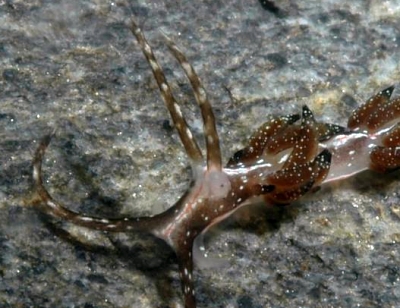
Dear Miquel,
It's nice to get a 'typical' example of Facelina fusca. Certainly the three records already on the Forum lack certain details, and as you say, one has white-tipped cerata. I will replace the photo on the Fact Sheet with yours. I guess the challenge now is for local enthusiasts to try and find more specimens and see just how much colour variation occurs in this species. Concerning other records from Spain, the only reference cited by Cervera et al. (2006) in their checklist is the one you mention (Ros, 1975) so clearly it has rarely been found there.
- Cervera, J. L., Calado, G., Gavaia, C., Malaquias, M. A. E., Templado, J., Ballesteros, M., García-Gómez, J. C., & Megina, C. (2006) An annotated and updated checklist of the opisthobranchs (Mollusca: Gastropoda) from Spain and Portugal (including islands and archipelagos). Boletín Instituto Espanol de Oceanografía 20: 1-122.
- Ros, J. 1975. Opistobranquios (Gastropoda: Euthyneura) del litoral ibérico. Investigación Pesquera, 39 (2): 269-372.
Best wishes,
Bill Rudman
Facelina fusca from Croatia
July 5, 2007
From: Tibor Beres
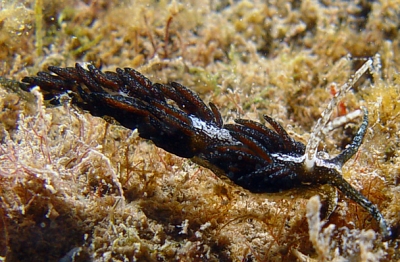
Hello Bill,
What species is this slug? I found two specimens and I suppose that they came to mate to the very shallow lagoon-like bay. (I also found more specimen of Dendrodoris limbata there.) This winter was warm so the temperature of the water was about 15 Celsius instead of the normal 10-11.
Locality: Pomer, Pula, 30 cm, Croatia, Adriatic Sea, 29 December 2006, lagoon like. Length: 2 cm. Photographer: Tibor Beres.
Thank you and best regards
Tibor
Beres.Tibor@mkk.szie.hu
Beres, T., 2007 (Jul 5) Facelina fusca from Croatia. [Message in] Sea Slug Forum. Australian Museum, Sydney. Available from http://www.seaslugforum.net/find/19253Dear Tibor,
We already have a nice photo of this animal from Croatia, which is interesting, because it does not seem to be that common in other parts of the Mediteranean. I have identified it as Facelina fusca but would appreciate confirmation from a local expert, as it does not have the reddish median line down its back, or a red line down each side, as is describd for this species.
Best wishes,
Bill Rudman
Facelina fusca? from Croatia
July 27, 2006
From: Mat Vestjens
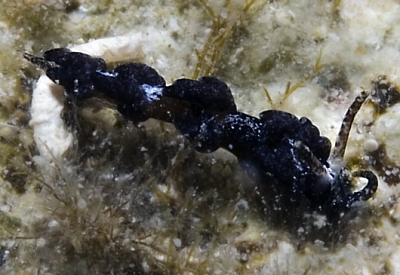
Hello Bill,
I have found this animal in May this year, but can't find much information. It looks a lot like the species photographed by Tom Turk [message #13521], but it seems to lack the red lines as you mention in your Factsheet for Facelina fusca. It can also be that this is hard to see, because the animal was rather small.
Locality: Selce, 4 metres, Croatia, Adriatic, 16 May 2006, Sandy floor. Length: 4 mm. Photographer: Mat Vestjens.
Can you help me on this?
Best regards,
Mat Vestjens
annenmat@natuurlijkmooi.net
Vestjens, M.G., 2006 (Jul 27) Facelina fusca? from Croatia. [Message in] Sea Slug Forum. Australian Museum, Sydney. Available from http://www.seaslugforum.net/find/17188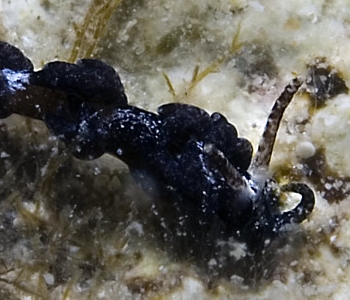
Dear Mat,
This certainly looks the same as Tom Turk's animal, but what we don't know is the variability of F. fusca. Very few animals of this species seem to have been reported so until the anatomy of specimens with and without red lines can be compared I don't think we can make a confident identification. Perhaps someone with firsthand knowledge of the fauna can help
Best wishes,
Bill Rudman
Facelina fusca? from Italy
April 21, 2005
From: Tom Turk
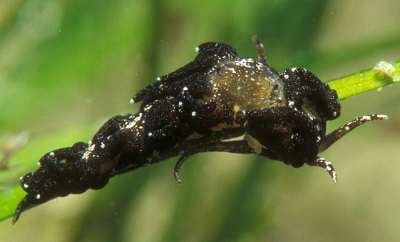
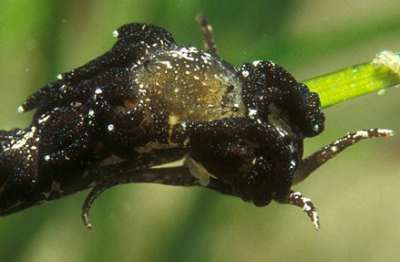
Dear Bill,
This specimen was taken at the beginning of June 2004 in the shallow waters near Trieste, Italy. I have no idea about identification of this nudibranch. Photographer: Gianni Pechiar
Please, help.
Tom Turk
tom.turk@bf.uni-lj.si
Turk, T., 2005 (Apr 21) Facelina fusca? from Italy. [Message in] Sea Slug Forum. Australian Museum, Sydney. Available from http://www.seaslugforum.net/find/13521Dear Tom,
This could possibly be Facelina fusca Schmekel 1966 but it lacks the red lines which run down the dorsal midline and each side of the body. It does however have the white rounded tubercules on the rhinophores. Any opinions form local experts would be welcome
Best wishes,
Bill Rudman
